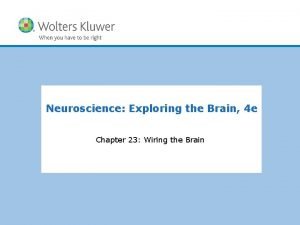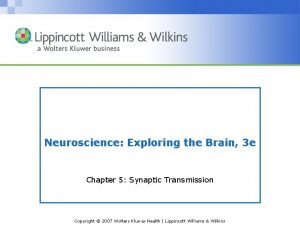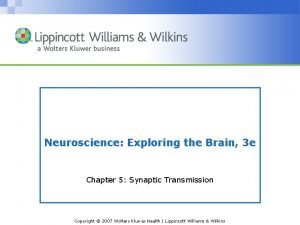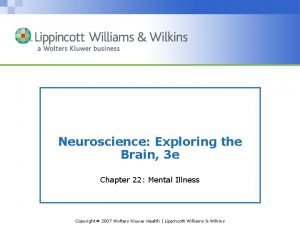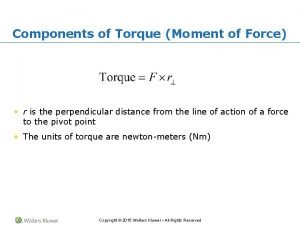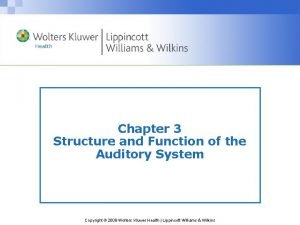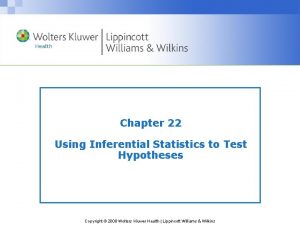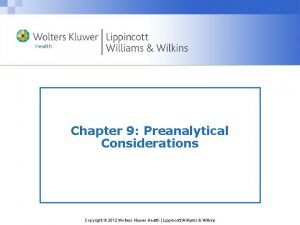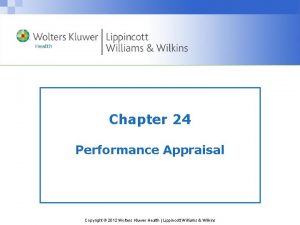Chapter 17 Somatic Therapies Copyright 2012 Wolters Kluwer














- Slides: 14

Chapter 17 Somatic Therapies Copyright © 2012 Wolters Kluwer Health | Lippincott Williams & Wilkins

Despite studies proving efficacy, it (ECT) remains the most controversial treatment in psychiatry. Hall & Bensing, 2005 Copyright © 2012 Wolters Kluwer Health | Lippincott Williams & Wilkins

Learning Objectives After studying this chapter, you should be able to • Compare and contrast the rationale for the use of electroconvulsive therapy (ECT), vagus nerve stimulation (VNS), transcranial magnetic therapy (TMS) and magnetic seizure therapy (MST), and deep brain stimulation (DBS) • Explain the ECT procedure • Identify the indications for using ECT • Discuss the conditions associated with increased risk during ECT • Recognize the presence of ECT side effects • Describe advances in ECT • Formulate nursing interventions to prepare a client for ECT Copyright © 2012 Wolters Kluwer Health | Lippincott Williams & Wilkins

Somatic Therapy Present-day somatic therapies include the following: • Psychopharmacology • Electroconvulsive therapy (ECT) • Vagus nerve stimulation (VNS) • Transcranial magnetic stimulation (TMS) • Magnetic seizure therapy (MST) • Deep brain stimulations (DBS) Copyright © 2012 Wolters Kluwer Health | Lippincott Williams & Wilkins

Electroconvulsive Therapy Indications for Use • Depression • Acute schizophrenia • Schizophrenia • Schizoaffective disorder • Depressive phase of bipolar disorder • Intractable mania • Clients at risk for suicide • Therapy-resistant depression • Delusional depression • Obsessive–compulsive disorder (OCD) • Catatonia • Pseudodementia • Neuroleptic malignant syndrome • Individuals who cannot take antidepressants Copyright © 2012 Wolters Kluwer Health | Lippincott Williams & Wilkins

Conditions Associated with Increased Risk During ECT • Special considerations • Conditions associated with increased risk Copyright © 2012 Wolters Kluwer Health | Lippincott Williams & Wilkins

Side Effects of ECT • Headache • Nausea • Disorientation • Memory disturbance • Postictal (seizure) agitation Copyright © 2012 Wolters Kluwer Health | Lippincott Williams & Wilkins

Advances in ECT • Seizure duration, characteristics, and end point • Augmentation strategies when treatments are ineffective – Changing the placement of electrodes – Selecting an alternate anesthesia – Using intravenous caffeine – Reducing the impact of benzodiazepines by administering the antagonist flumazenil (Anexate) – Blocking serotonin uptake by administering pindolol (Visken) Copyright © 2012 Wolters Kluwer Health | Lippincott Williams & Wilkins

Electrode Placement (A) Bitemporal electrode placement (B) Unilateral electrode placement Copyright © 2012 Wolters Kluwer Health | Lippincott Williams & Wilkins

Guidelines for ECT • ECT is a major treatment with well-defined indications, and it should not be reserved as a last resort. • The most common use of ECT is with clients who have not responded to alternative treatments such as pharmacotherapy, exhibit a deterioration in clinical symptoms, or exhibit suicidal ideations. • There are no absolute contraindications to ECT; however, consideration is given to the degree of risk to potential benefits of ECT. Copyright © 2012 Wolters Kluwer Health | Lippincott Williams & Wilkins

Nursing Interventions for the Client Receiving ECT • Client education prior to ECT • Informed consent • Client preparation for treatment • Care during ECT and the recovery period • Resources for client education Copyright © 2012 Wolters Kluwer Health | Lippincott Williams & Wilkins

Alternative Somatic Therapies • Vagus nerve stimulation (VNS) – Epileptic seizures – Refractory depression • Transcranial magnetic stimulation (TMS) – Major depression – Auditory hallucinations – Other psychiatric and neurological disorders • Magnetic seizure therapy (MST) – Depression Copyright © 2012 Wolters Kluwer Health | Lippincott Williams & Wilkins

Key Terms • Clitoridectomy • Postictal agitation • Deep brain stimulation (DBS) • Psychosurgery • Electroconvulsive therapy (ECT) • Sterilization • Electronarcosis • Insulin shock therapy • Lobotomy • Somatic therapy • Transcranial magnetic stimulation (TMS) • Vagus nerve stimulation (VNS) • Magnetic seizure therapy (MST) • Physiotherapy Copyright © 2012 Wolters Kluwer Health | Lippincott Williams & Wilkins

Reflection The chapter-opening quotes present “pro” and “con” views of ECT for debate. • Which view would you defend? • If your answer is “con, ” what additional information would you offer to defend your choice? • If your answer is “pro, ” explain the rationale for your choice. ? Copyright © 2012 Wolters Kluwer Health | Lippincott Williams & Wilkins
 Wolters kluwer health
Wolters kluwer health Wolters kluwer health
Wolters kluwer health Edgar lopategui corsino
Edgar lopategui corsino Wolters kluwer
Wolters kluwer Shunting inhibition
Shunting inhibition Wolters kluwer health
Wolters kluwer health Lippincott williams & wilkins
Lippincott williams & wilkins Wolters kluwer
Wolters kluwer Wolters kluwer
Wolters kluwer Wolters kluwer health
Wolters kluwer health Wolters kluwer
Wolters kluwer Chapter 25 assessment of cardiovascular function
Chapter 25 assessment of cardiovascular function Wolters kluwer health
Wolters kluwer health Wolters kluwer
Wolters kluwer Wolters kluwer
Wolters kluwer



